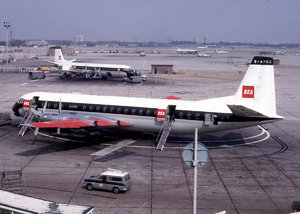Vickers Vanguard
|
|
The name "Vanguard" had earlier been used on a civilian model of the Vickers Virginia bomber, other versions of the same aircraft being the Victoria and Valentia.
The Vanguard (Type 950) was a short/medium-range turboprop airliner introduced in 1959 by Vickers-Armstrong, a development of their successful Viscount design with considerably more internal room. The Vanguard was introduced just before the first of the large jet-powered airliners, and was largely ignored by the market. Only 43 were produced, used only by Trans-Canada Airlines (TCA) and British European Airways (BEA). After only about 10 years service TCA experimentally converted one of theirs to a freighter configuration, calling it the Cargoliner. This was considered rather successful, and in the early 1970s most were converted to freighters, those from BEA becoming the Merchantman. These freighters remained in service for many years, with the last one (G-APEP) only retiring in 1996.
Vickers_vanguard.jpg
| Contents [hide] |
History
Originally designed to a BEA requirement for a 100-seat aircraft to replace their Viscounts. The original Type 870 design was then modified when TCA expressed their interest in the design as well, and Vickers returned the updated Type 950 that filled both requirements.
The main difference between the Viscount and Vanguard was the construction of the fuselage. The Vanguard started with the original Viscount fuselage, but cut it off about 1/2 of the way up from the bottom, and replaced the top section with a larger-diameter fuselage to give it a double bubble cross-section (similar to the Boeing Stratocruiser). The result of the larger upper portion was a considerably roomier interior, with increased cargo capacity below the floor.
With this larger, and heavier, fuselage came the need for a new engine to lift it. Rolls-Royce was ready for this, and delivered their new Tyne design with a nominal 4,000 hp (3,000 kW) (as compared to the Viscount's Dart of about 1,700 hp (1,300 kW)).
The first Type 950 prototype flew on 20 January 1959, entering service in 1961. The last Merchantman (Vanguard) was retired by Hunting Cargo Airlines on 30 September 1996 and donated to Brooklands Museum on 17 October.
Variants
- Type 951: BEA, 20 ordered, 6 delivered
- Type 952: TCA, more powerful engine and stronger fuselage for height weights, 23 delivered
- Type 953: BEA, more powerful engines and more seating, 14 delivered replacing 951's
Specifications (Type 952)
General Characteristics
- Crew: 2-3
- Capacity: 139 passengers
- Length: 122 ft 10 in (37.50 m)
- Wingspan: 118 ft 7 in (36.10 m)
- Height: 34 ft 11 in (10.60 m)
- Wing area: 1,527 ft² (142 m²)
- Empty: 82,500 lb (37,421 kg)
- Loaded: 141,000 lb (63,977 kg)
- Maximum takeoff: lb ( kg)
- Powerplant: 4x Rolls-Royce Tyne RTy.11 Mk 512 turboprops, 5,545 hp (4,135 kW) each
Performance
- Maximum speed: 425 mph (684 km/h)
- Range: 1,830 miles (2,945 km)
- Service ceiling: 30,000 ft (9,145 m)
- Rate of climb: ft/min ( m/min)
- Wing loading: 92 lb/ft² (450 kg/m²)
- Power/Mass: 0.16 hp/lb (0.26 kW/kg)
External link:
Related content
Related development:
Comparable aircraft:
Designation sequence: 951 - 952 - 952
|
Lists of Aircraft | Aircraft manufacturers | Aircraft engines | Aircraft engine manufacturers Airports | Airlines | Air forces | Aircraft weapons | Missiles | Timeline of aviation |

